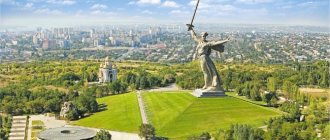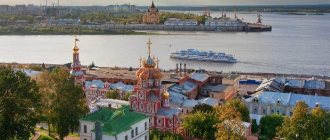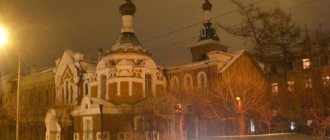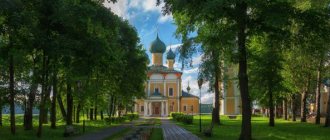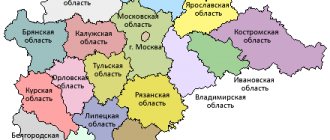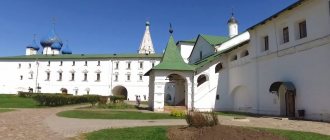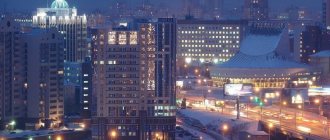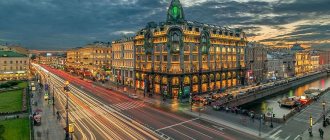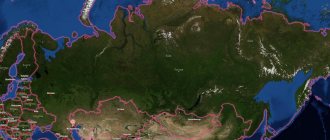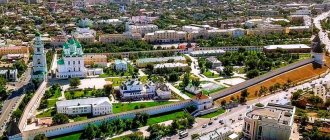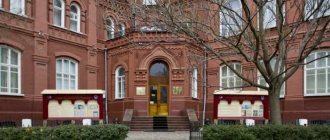Astrakhan is one of the largest cities in the south of the European territory of Russia and the Volga region. An important historical, economic and cultural center. It is located in the upper reaches of the Volga delta, not far from its confluence with the Caspian Sea. Built on the islands of the Caspian lowland. The area of the city is 208.7 km2. Population: 533,925 people. The distance to Moscow is 1411 km.
What federal district is Astrakhan? At first glance it seems that Privolzhsky. But actually it is not. Astrakhan - Southern Federal District.
The city includes 4 administrative districts: Leninsky, Sovetsky, Kirovsky, Trusovsky.
The passage of time is 1 hour ahead of Moscow and corresponds to Samara.
Geographical features
The city of Astrakhan is located in the southeast of the European territory of Russia (ETR), in the southeastern part of the East European Plain. The terrain is flat and level. The height above sea level is about 23 m.
Astrakhan is characterized by a sharply continental climate with pronounced daily and annual temperature differences. The amount of precipitation is low - 234 mm per year. This is associated with a high degree of aridity. The maximum of their fall occurs in May (28 mm), and the minimum in February (12 mm). In the southern part of the city, precipitation does not even reach 200 mm per year, while in the northern part it reaches 290 mm per year. The landscapes in the vicinity of Astrakhan correspond to dry steppes and semi-deserts.
About the origin of the name “Astrakhan”
The most accurate original version of the name of the city is the toponym “Hadji-Tarkhan”, mentioned for the first time in 1333 by the Arab traveler Muhammad Ibn-Battuta.
In this case, “haji” (Arabic) means the title of the ruler (viceroy), who was also a clergyman in Islam, and “tarkhan” (Mongolian) is a safe-conduct from the khan on immunity, the basis of “city liberties.”
Founded at the beginning of the 14th century. on the right bank of the Volga, this old Tatar Astrakhan (the settlement is almost completely washed away by the river) with the peaceful annexation of the Lower Volga to Russia was moved in 1557-1558. Russian administration to the left bank and 12 km to the south, where the city center is now located.
Other interpretations (“Tarkhan of the As tribe”, “city of the Khan’s daughter Astra”, “place of the fairy-tale dragon king Adzhidaar”) are less reliable, although they are found in ongoing discussions.
Administrative division
In the administrative division of the country, the Astrakhan region is the southern federal district. Astrakhan, as mentioned above, is divided into 4 districts:
- Kirovsky. Covers an area of 17.6 km2. Number of inhabitants – 117,996 people. The area is located in the eastern part of the city.
- Soviet. It has an area of 100 km2 and a population of 151,356 people. Occupies the southern and southeastern parts of the city.
- Leninist. Covers an area of 200 km2. The population is 147,952 people. Occupies the northeastern part of the city.
- Trusovsky. It stretches along the western border of the city, and on the east it borders with other districts. The area of the district is 76 km2, and the population is 115,200 people.
Economy of Astrakhan
Industry is quite developed in Astrakhan, especially the fuel and energy complex. It is associated with oil and gas production on the Caspian Sea shelf. Fish production and processing is quite developed. However, due to the decline in fish stocks, it is gradually dying out.
At the same time, the production of vegetables and fruits is growing. There is also a meat processing plant, a distillery, a confectionery factory, a cannery and a cheese factory.
There are shipbuilding, ship repair and chemical industry enterprises. Thermal power plants operate, which cover most of the Astrakhan region's electricity needs.
Transport Astrakhan
There are various types of transport in the city. Astrakhan is a major center of road transport. 4 federal highways pass through it, along which you can directly get to Moscow, Makhachkala, Volgograd, Stavropol and the cities of Kazakhstan. Bypass highways are being built.
Water transport is represented by motor ships, boats, and military vessels. However, passenger water transport has declined in recent years, and the fleet of ships has sharply decreased.
Air transport is represented by Astrakhan International Airport. Regular flights operate to the following cities: Istanbul, Sochi, Aktau, Moscow.
Railway transport is one of the oldest in the city. There is a railway station Astrakhan 1, as well as 8 railway stations.
City transport is represented by buses and minibuses. Minibus taxis have the most routes – 79. They are the main type of urban public transport.
Until 2007, there was tram transport, and until 2022, trolleybus transport.
Astrakhan
Video: Astrakhan from above
Basic moments
Sunny Astrakhan is the recognized tourist capital of the Lower Volga region. A decent hospitality infrastructure has been created in the city, hotels have been built, and numerous restaurants have opened their doors. Guests of Astrakhan can expect theaters and museums, exciting excursions, and river boat trips. Dozens of fishing and hunting bases built in the Volga delta encourage active recreation.
Among the main local attractions are the architectural complex of the medieval Kremlin, the unique thickets of lotus in the protected channels of the Volga delta. Astrakhan has long been famous for the variety of gifts of the great river. The markets offer fish delicacies, southern fruits, and original souvenirs.
Astrakhan is connected to Moscow and other cities by convenient transport arteries. There is an international airport near Astrakhan, trains from major cities of the country arrive at the railway station, and the river harbor receives cruise ships plying along the Volga.
History of Astrakhan
The first written mention of the Golden Horde city of Hadji-Tarkhan on the right bank of the lower reaches of the Itil (Volga) River belongs to the Arab traveler Ibn Battuta, who visited here in 1333. He reports that Hadji-Tarkhan stood on a hill on the western bank of the Volga, where caravan and river trade routes intersected. Merchants from India, Persia, and Armenia played a leading role in trade. But at the end of the 14th century, the prosperous city was burned by Tamerlane’s troops.
Since 1459, here was the capital of the Astrakhan Khanate, one of the “ruins” of the collapsed Golden Horde. The city, now called “Ajarkhan,” was once visited by the Tver merchant Afanasy Nikitin and briefly described it in his book “Walking across Three Seas.”
In the 16th century, the Astrakhan rulers entered into an alliance with the Crimean Tatars, threatening the security of the Moscow state, and in 1556 the army of Tsar Ivan the Terrible conquered the hostile Khanate. Voivode Ivan Cheremisinov-Karaulov decided not to restore the destroyed city, but to build new fortifications 10 versts downstream of the Volga, on the low-lying left bank. This decision was correct and far-sighted: subsequently, the flow of the mighty river washed away the hill on which Ajarkhan once stood, and most of the ruins collapsed into the water.
The fortifications of the new Astrakhan were initially made of logs, but by the 80s of the 16th century, stone walls and towers were erected here, which laid the foundation for the fortification complex of the Astrakhan Kremlin. Large-scale construction was completed during the era of Boris Godunov. At that time, the main channel of the Volga was located near the western walls of the fortress. Over time, the river washed out a new channel, and the oxbow became shallow and silted up. Today the Kremlin stands on a triangular island washed by channels.
Life in the city was hectic. In 1569, Astrakhan withstood a 10-day siege by Turkish troops. In 1606, the city became the center of an uprising led by Ivan Bolotnikov, and in 1611 the impostor False Dmitry appeared here, posing as the son of Ivan the Terrible. In the city, the Polish adventurer Marina Mniszek, illegally elevated to the Russian throne, was hiding from persecution.
In 1670, Astrakhan residents opened the city gates to the 12,000-strong army of Stepan Razin. The fortress garrison with 500 cannons went over to the side of the rebels. The riot in Astrakhan continued even after the execution of the Cossack ataman, until the unrest was pacified by the boyar Ivan Miloslavsky.
Another uprising, caused by the reforms of Peter I, broke out in Astrakhan in 1705-1706. The Kremlin archers, as well as local Muslims, indignantly rejected the order to cut their beards and wear European clothes. The Astrakhan governor Timofey Rzhevsky, who forcibly introduced innovations, was killed. The king sent regular troops to suppress the rebellion.
In 1717, Astrakhan received city status and became the center of the Astrakhan province created by decree of Peter I. The emperor himself was here, supervising the construction of the Caspian fleet. At one time, the Kremlin housed the entire royal retinue and military headquarters, which developed plans for a campaign in Persia.
In 1722, not far from the Kremlin fortifications, on the shore of the navigable Kutum branch of the Volga, a port was founded that could receive sea vessels coming from the Caspian Sea. Instead of outdated models of clumsy merchant ships, sailing ships began to be built here according to the Dutch model. Subsequently, a more convenient location was chosen for the port harbors on the right bank of the main channel of the Volga.
By decree of Catherine II, Astrakhan was ranked among the cities where master architectural plans were supposed to be developed. The proposals of Astrakhan city planners began to be implemented at the turn of the 18th-19th centuries. Wooden buildings became a thing of the past, new buildings were erected from brick, and the facades of public buildings were faced with stone. City streets and neighborhoods acquired European features with an oriental flavor. The ancient buildings of caravanserais, rebuilt in the 19th century, have survived to this day.
By the beginning of the last century, the city had more than 120,000 inhabitants. Industrial enterprises and shipyards operated here. But Astrakhan was famous, first of all, for its delicious caviar and delicate Caspian sturgeon, smoked beluga balyks, dried roach, sweet Astrakhan watermelons and aromatic fruits. A railway station and electric lighting appeared in the city, telephone lines were laid, and cinemas opened their doors.
During the civil war, fierce battles between Red Army units and White Guards and Cossacks took place on the streets of Astrakhan. Fires raged in the central neighborhoods. The new government was established here by the prominent revolutionary Sergei Kirov. During the Great Patriotic War, hospitals operated in Astrakhan, and oil from Baku fields came through the port. German troops intending to break through to the Caspian Sea were stopped 100 km from the city.
In the 50-90s of the last century, Astrakhan grew significantly. By the beginning of the current century, the historical center and the Astrakhan Kremlin complex had been restored, and the Volga embankment had been reconstructed. The city's tourism infrastructure continues to develop. Consulates of neighboring states of the Caspian region - Iran, Kazakhstan, Turkmenistan - are open here, and the Azerbaijani business center also operates.
Geography
Astrakhan is located on the flat Caspian lowland, at the top of the triangular delta of the Volga, 1,400 km southeast of Moscow. A curious geographical feature of the landscape: the plain extends below the level of the World Ocean. Thus, the central quarters of Astrakhan are located at minus 23 m. Here, the mouth of a deep river flowing into the Caspian Sea is divided into hundreds of branches, straits and swampy oxbow lakes, creating many islands. There are also numerous shallow lakes, among them there are saline reservoirs with bitterly salty water, unsuitable for drinking. The delta area is more than 20,000 km². Millions of birds nest on the banks overgrown with reeds and sedges. The waters are rich in fish, in particular sturgeon species (beluga, sturgeon, stellate sturgeon).
A natural attraction of the Astrakhan region is the Volga River Delta biosphere reserve, spread over an area of 67,917 hectares. 280 species of birds find shelter here, many of which are rare or endangered wetland species. Among them are Egyptian herons, Dalmatian pelicans, and spoonbills with funny spoon-shaped beaks. The delta serves as an “intermediate airfield” for seasonal migration of waterfowl. The dense willows, reeds and marsh bushes are home to wild boars, wolves, foxes, otters and stoats.
On the Caspian seaside in the Volga delta, relict thickets of lotuses have been preserved - this is where the northern cordon of the spread of sacred flowers of eastern religions passes. Under natural conditions, such a magnificent miracle of nature can only be seen in the reservoirs of the Far East. And also in the delta of the Kuban River, in the Krasnodar Territory, where naturalists transplanted these aquatic flowers at the beginning of the last century. Lotuses bloom from mid-summer to early autumn.
On the territory of the Astrakhan region there is another famous natural attraction - the salt lake Baskunchak. The reservoir and its surroundings have been declared a state reserve.
Astrakhan occupies both banks of the Volga and 11 islands connected by dozens of bridges. Several branches of the Volga also flow within the city limits. They are often called separate rivers (Kutum, Bolda, Varvatsievsky Canal). Residential and industrial areas stretch along the river for 45 km. In the Trusovsky district, on the right bank, there is the Astrakhan sea trade port, where 26 berths have been built for large cargo ships. In the summer season, Astrakhan receives dozens of cruise ships with thousands of tourists and private yachts of travelers.
Climate
Astrakhan is located in the temperate continental steppe climate zone. Winters here are quite mild, with thaws often occurring due to southern winds. The usual air temperature in January ranges from –7…–5 °C. Precipitation often falls in the form of rain or sleet, which quickly melts in the sun. However, there are also short-lived severe frosts exceeding –30 °C.
Spring comes to Astrakhan by mid-March, and by the second ten days of May the air warms up to +20...+24 °C. In summer, the city is warm and even hot - due to the proximity of semi-deserts. In the first ten days of June it is already +25…+30 °C. In mid-summer 1991, meteorologists recorded extreme heat: +41 °C. It rarely rains in Astrakhan; the region is considered arid. However, sun-loving melons – the famous Astrakhan watermelons – have been grown here for centuries.
City beaches are filled with vacationers from late May to September. During this period, the water temperature in the Volga fluctuates between +19…+26 °C.
Sights of Astrakhan
The symbol of the city is the Astrakhan Kremlin. The powerful walls of the citadel are fortified with seven towers, three of which are travel towers. The towers house thematic museum exhibitions and observation decks. Museums are also located in the barracks and guardhouse buildings, and in the artillery workshop.
The Kremlin is decorated with a magnificent complex of Orthodox churches. In 1568, the Trinity Monastery was founded in the northeastern part of the citadel. The monastery is still active today. It includes the five-domed Cathedral of the Life-Giving Trinity (1603). The Sretenskaya and Vvedenskaya churches and the Refectory building (1606-1620) are adjacent to the main volume. A chapel was erected near the walls of the cathedral, in which the first abbot of the monastery, Archimandrite Kirill of Astrakhan, was buried.
The gate church of St. Nicholas was built above the neighboring St. Nicholas entrance to the citadel. Nearby stands the corner Artillery Tower. At the Powder Compound, at its foot, ancient fortress cannons, siege mortars are exhibited, and cast iron cannonballs are on display.
At the turn of the 17th-18th centuries, the Cathedral of the Assumption of the Virgin Mary was erected near the eastern wall of the Kremlin. The temple was created in the Moscow Baroque style. In the cathedral crypt there is a church in the name of the Vladimir Icon of the Virgin Mary. By the will of fate, the Georgian kings Vakhtang VI and Teimuraz II were buried here, and the ashes of several Astrakhan bishops rest in the sarcophagi. The ground floor is surrounded by an arched gallery. The two-story facade, decorated with stucco, is cut through by narrow windows. The cathedral is crowned with 5 emerald domes with golden crosses. Wide staircases lead to the entrance to the temple, located on the second level. Opposite the portal there is a round platform - the Execution Place, where criminals were executed.
The Bishop's Chambers (1677) are adjacent to the southern facade of the Assumption Cathedral. Nearby, above the Prechistensky Gate, rises an 80-meter cathedral bell tower, built at the dawn of the last century. It is interesting that since the beginning of the 18th century, the belfry was erected on this site three times, but due to quicksand in the riverine soil, cracks appeared in the structures, the towers sagged, deviated from the vertical axis, and had to be dismantled and rebuilt again. The facades of the current four-tier bell tower are decorated with relief decoration, kokoshniks, and columns. There is a clock above the third tier. The gilded dome of the Prechistenskaya Bell Tower with a 7-meter cross is visible for many kilometers.
The Astrakhan Kremlin is surrounded by quarters of the ancient settlement - the White City. Previously, the entire White City was surrounded by a brick wall, but the dilapidated fortifications were dismantled in the century before last. Only the tent-roofed tower of the Spaso-Preobrazhensky Monastery, which was part of the city fortifications, reminds of them. Historical buildings and Muslim mosques have been preserved on the streets. The buildings of the Demidovsky farmstead and the partially surviving buildings of the caravanserais of the merchant farmsteads - Armenian, Persian, and Indian - attract attention.
In the area of the fortress, shipping canals were once dug, but over time they lost their significance. Many of them were covered with soil, and streets were laid on top and houses were built. So, Admiralteyskaya Street follows the bed of the old canal. Part of another canal in the area was turned into a landscaped lake where swans settled. An elegant rotunda is built on an island in the center of the reservoir. In winter, the lake turns into a skating rink.
Elements of oriental architecture are woven throughout the architectural appearance of the Old Town. In the 19th century, wealthy Astrakhan residents built luxurious mansions here in the Empire style, with many houses decorated with Moorish arches, lancet windows, and geometric patterns reminiscent of arabesques.
On a hot day, it’s nice to stroll by the water along the landscaped embankments of the Varvatsievsky Canal and the Kutum River. A beautiful promenade has been created on the Volga embankment. A monument to Peter I was unveiled here in 2002. A bronze sculpture of the emperor stands on a pedestal made of pink granite. At the foot lie ancient ship anchors, reminiscent of the fact that the sovereign ordered the construction of the first sailing ships of the Russian Caspian Fleet at the Astrakhan shipyards.
In memory of the crews of the Volga Flotilla ships sunk by German aircraft in 1942, a monument to the lost ships was erected on the embankment. The memorial composition is made in the form of two crossed massive anchors braided with steel chains. In the Sea Garden there is a monument in the form of a lighthouse tower. It was installed in the 20s in memory of the sailors who died during the Civil War.
At the entrance to the Museum of Military Glory on Akhmatovskaya Street, 7, there is a sculpture of a Cossack in a World War I uniform with a sword drawn in his hand. At the beginning of the 20th century, the headquarters of the Cossack regiments was located in this building. The outline of the St. George's Cross is visible above the figure. The monument, opened in 2015, is dedicated to the Astrakhan Cossacks, defenders of the Fatherland.
The rich multinational culture of Astrakhan is reflected in the monuments to the Persian poet and philosopher Omar Khayyam, the Ukrainian poet Taras Shevchenko, and the Kazakh composer Kurmangazy Sagyrbaev. In the university square there is a granite sculpture of the outstanding Turkmen poet Magtymguly, who visited Astrakhan in the 18th century. On Admiral Nakhimov Street, at the beginning of the last century, the Tatar settlement was noisy, where the poet Gabdulla Tukai lived in 1911. A monument to the great Tatar poet was erected here.
In the squares and avenues of the city you can see modern street and park sculptures: “Lady with a Dog”, “Vobla the Nurse”, “Shoe Shine Man”, “Family”. There is also a monument to a giant sturgeon.
There are about 50 bridges in Astrakhan - railway, road, pedestrian. Astrakhan bridges are especially beautiful in the evenings, when the structures are illuminated by floodlights. Lovers' Bridge is popular among young people. Wedding processions traditionally stop here. The newlyweds close the locks on the bridge railings and throw the keys into the water. By the way, the Astrakhan Wedding Palace on Red Embankment is one of the architectural landmarks of the city. This luxurious building, built in Art Nouveau style in 1910, housed the business center of the Astrakhan merchants - a commercial and industrial exchange with an elite club.
In 2012, the shores of the Volga backwater, in the center of the city, were connected by a bridge built in honor of the friendship of Azerbaijan and Russia. The railings of the graceful passage are made using artistic forging techniques; nozzles are built into the base of the deck, from which jets of water shoot out, creating miniature waterfalls with rainbow tints. Heydar Aliyev Square is located near the bridge.
Beaches
Within Astrakhan there are several beaches, and they are located not only on the banks of the Volga. For example, you will find sandy beaches on the banks of the shallow Serebryannaya Volozhka channel or on the Pryamaya Bolda River. Accessible places for swimming can also be found in the outskirts of the city. However, almost all of them do not have even minimal beach infrastructure. The reason is the annual floods of the Volga, which cover the gently sloping banks in the spring and destroy light beach structures. Citizens and tourists come here with their own bedding and have picnics by the water.
The exception is the municipal beach, located on the eastern shore of City Island, opposite Komsomolskaya embankment. On a 500-meter stretch of sandy coast there are “mushrooms”, canopies made of reeds. The entrance to the water is gentle, the bottom is covered with sand. The area is cleaned daily. Sports grounds are equipped, there are toilets and changing cabins. There are cafes and fast food kiosks on the shore. There is a fenced children's swimming pool with a water slide on the beach. There are inflatable islands in the water area where swimmers can relax and sunbathe. Entrance to the beach is free, you will only need to pay for sun loungers and luggage storage.
From the center you can walk here along the New Bridge that crosses the island, or take a minibus. There is a ramp for passenger cars from the bridge to the island. Water taxis with a capacity of 6-12 passengers run from the pier at the embankment to the island. The cost of the crossing is 50 rubles. By the way, these boats can also be used to get to other recreational areas near the water.
10 km east of the center of Astrakhan, in the village of Nachalovo, there is a cozy beach on the banks of the Bolda River. Here in the summer, sun loungers are rented, changing rooms, and kiosks with fast food and drinks are installed. Minibuses run here from the Red Bridge to neighboring villages.
The wild beach is popular in the village of Rassvet, which is 25 km from the city center, in the Narimanovsky district. The landscape of the vast coastal strip is formed by sand dunes up to 40 m high. Townspeople often come here on weekends with barbecues, pitch tents, and bring light kayaks. Extreme sports enthusiasts organize rallies across the dunes in SUVs and buggies. You can get to the village by buses No. 122, 132, 548. From there it takes about a 20-minute walk to the coast. You can get to the beach only with an all-wheel drive SUV; from the E116 highway, the path to the water lies through loose sand.
Among the popular beaches in the nearby suburbs is a recreation area in the village of Assadulaevo, located downstream of the Volga, about 20 km from the Astrakhan Kremlin, near the airport. There are changing cabins, sports grounds, and toilets. Water buses run from the city center to the beach during the season. You can also get here by minibus No. 101. The beach is located on a long sandbank; in order to take a full swim you will have to walk through shallow water for about 100 meters.
The city is separated from the Caspian Sea by only 64 km, but the Volga delta has turned this Caspian coast into swampy and freshwater thickets of reeds. So there are no sea beaches near Astrakhan.
Entertainment in Astrakhan
Tourists interested in history will find it interesting to stroll through the museums of Astrakhan. The past of this region is most fully represented in the 15 halls of the local history museum, located in an ancient building on Sovetskaya Street, 15. The exhibitions introduce the nature of the Volga Delta, the history and culture of the peoples who have inhabited the region since ancient times. Attention is drawn to the collections of the Armory Room and the archaeological artifacts of the “Gold of the Nomads” exhibition. Here you can examine the perfectly preserved pectoral discovered in the tomb of a Sarmatian leader, and precious jewelry.
It is also interesting to visit the city history museum (Ulyanov St., 9). The exhibition features antique furniture, products of Astrakhan artisans, and ancient household items. The interiors of a bourgeois family's house, a merchant's dining room, and a noble's living room have been recreated.
The Astrakhan Art Gallery is located in an old mansion on Sverdlova Street, 81. The collections of this museum include paintings by Russian painters of the 18th-20th centuries and works by avant-garde artists. Among them are paintings by Wassily Kandinsky, Kazimir Malevich, Robert Falk.
There are several theaters and acting studios in the city. The impressive building of the Opera and Ballet Theater was built in 2012 in a park area on Maria Maksakova Street, 2. The theater for young spectators also boasts a new building. Near the entrance there is a sculptural composition “Ivanushka and the Little Humpbacked Horse”. There are also drama and musical theaters in Astrakhan; children enjoy watching performances in the puppet theater.
Local travel agencies offer sightseeing tours of the historical city center with a visit to the Astrakhan Kremlin. Walking tours last up to 4 hours, cost from 3800 rubles.
It is interesting to attend a 4-hour educational excursion to the sturgeon farm “Astrakhan Fishka”, where 40 closed reservoirs are equipped for raising young delicious fish, as well as more than 150 cages along the river banks. Here tourists can expect a fish restaurant with original dishes: royal sterlet fish soup, sturgeon steaks, balyks. After lunch, you can swim in the river and sunbathe on sun loungers. The fish store sells caviar, selected fillets of sturgeon, catfish, pike, ready-made delicacies and souvenirs. Fishing enthusiasts can cast their fishing rods on the river bank (you need to bring your own gear). The cost of a trip in a guide's car is from 14,300 rubles; lunch at a restaurant is included in the tour.
Excursions by motor boat to the lotus lakes and creeks in the lower reaches of the Volga delta will take about 10 hours. The cost of the tour is 18,100 rubles.
An interesting tourist location appeared in 2022 in the vicinity of Astrakhan, near the village of Selitrennoe. On the bank of Akhtuba, one of the branches of the Volga delta, for the filming of the film “Horde”, realistic scenery was built for the medieval Tatar city of Sarai-Batu. After filming was completed, they decided to turn the colorful scenery into an entertainment center for tourists. Colorful festivals and theatrical reconstructions of historical events are held here. In the fake fortress there is a real palace of the khan with a museum exhibition, and a cafe serving national cuisine. Camel rides are organized for tourists, and you can do archery at the shooting range.
A trip from Astrakhan to the cinema town will take no more than 2 hours, the distance is 120 km to the north. Tourists are received here from 10:00 to 18:00 daily. The entrance ticket costs 400 rubles, this amount includes an audio guide.
The private fishing base “Sarai-Batu” is located nearby. Here you can rent houses by the water (from 800 rubles per day), and offer rental gear and motor boats (1,200 rubles per day). At the base you can cut up the catch and cook it on the grill.
There are dozens of similar bases scattered around the capital of the Lower Volga region. They guarantee fishing enthusiasts an excellent holiday, a hefty and varied catch. The fishermen's catch includes pike and tench, perch and catfish, and carp. The hook catches asp, roach, sabrefish, and crucian carp.
Purchases
Astrakhan is famous for its bazaars, the main one is the Selenskie Isady market, which is located on the square near the Intercession Cathedral. The market's specialization is the sale of Astrakhan fish, both fresh and prepared in various ways. The main delicacies are delicious sturgeon balyks and black caviar. Wood-smoked catfish, salmon caviar, carp, pike fillet marinated in wine sauce, and dried roach are incredibly tasty.
In August, oblong Astrakhan watermelons appear on the markets. These famous melons do not lose their taste for two months, so you can safely buy the striped berry as a treat for your sweet tooth. Watermelons of the Astrakhan variety rarely weigh more than 6-7 kg; for 1 kg at the market they ask for 23-25 rubles. Local housewives sell candied watermelon rinds and offer watermelon jam and syrups.
In Astrakhan souvenir shops, pay attention to warm clothes, blankets made of camel fur, and elegant accessories made of fish skin. In art salons you can buy copies of famous Sarmatian jewelry found in steppe mounds. You can decorate your home living room with dynamic hand-painted porcelain sturgeon figurines. Traditional inexpensive souvenirs from Astrakhan are cute baskets woven from river reeds, jars of salt from the shores of Lake Baskunchak.
Cafes and restaurants
The number of culinary establishments in Astrakhan is approaching three hundred. One of the most luxurious restaurants in the city is Sobranie, located in an old mansion. The menu includes dishes of Russian, Caucasian and Oriental cuisine. Lunch here will cost 1500-1700 rubles per person.
The top ten best restaurants of local fish cuisine include “Beluga” (Fioletova St., 1-3), “Pike” (Lieutenant Shmidt St., 5-A). The average bill is 1100 rubles per person. The Serbian restaurant “Gallery Nikol” on Nikolskaya Street, 11 is popular. The menu includes dishes of Serbian cuisine. You can have a hearty and tasty meal here for 1000 rubles per person. Lunch at the stylish restaurant of signature cuisine “Brunette and Poacher” on Kommunisticheskaya Street, 7 will cost approximately the same amount. On weekdays, the doors of the establishment are open from 12:00 to 02:00.
A magnificent evening with views of the Volga expanses awaits visitors to the Poplavok restaurant. It is located on a landing stage moored at the embankment, directly opposite the musical fountain. Price range – 600-1200 rubles per person.
There are many establishments of national cuisine open in Astrakhan. Uzbek pilaf is served in the Sholi teahouse on Uritsky Street, 5. Nearby is the Japanese restaurant Yamato, Italian cuisine is presented in the San Pizza trattoria on Kosmonavtov Street, 14.
You can have a tasty and inexpensive meal in the self-service cafe “Samovar on Minusinskaya”; the average bill per guest is 250-300 rubles. You can spend the same amount by visiting the neighboring Gastromarket on Minusinskaya. Here you can order food to go, buy fresh pastries, fish pies, and desserts.
Where to stay
More than 200 hotels of different categories have been built in Astrakhan - from luxurious five-star complexes to modest mini-hotels and guesthouses. In the vicinity of the city, tourists are welcomed by beach recreation centers and fishing camps.
The best hotels are located along the banks of the Volga. The rating of Astrakhan hotels is headed by Grand Hotel Astrakhan (Kuibysheva St., 69). There is a spa center with a swimming pool, a beauty and fitness salon, and a gym. Business people use offices in the business center and conference rooms. Guests are served in a restaurant with panoramic views of the Volga. Room rates range from 5,322 to 6,489 rubles per day.
At Krasnaya Naberezhnaya, 3, the Victoria Palas 4* hotel was built. Guests can enjoy a restaurant and a cozy lounge bar. The hotel has a swimming pool, sauna with jacuzzi, beauty salon, massage rooms. You can rent a room here for 2916-4739 rubles per day.
Tourists praise the impeccable service in the new business class hotel “Caucasian Prisoner” 4*, located in a park area, 5 minutes from the Golden Backwater of the Volga (Bezzhonova St., 97-E). There is a beauty salon, a swimming pool and a sauna. The restaurant's chefs specialize in Azerbaijani and Oriental cuisine, and evening entertainment is offered. The rooms are equipped with TVs, safes, refrigerators, minibars, and the interiors are designed in Art Nouveau style. The cost of daily accommodation is 3500-4666 rubles.
Near the railway station and the Central Bus Station there is the Cosmos Hotel 4* (Henri Barbussa St., 29-B, letter A). The hotel belongs to the international chain Radisson Park Inn. The rooms are equipped with comfortable furniture, flat-screen TVs, minibars, safes, and new plumbing equipment. The 14-story building houses 132 rooms, a business center, a conference room, a restaurant, and a grill bar. Opposite is a fish market and a large shopping center. The price range for accommodation is 2260-3570 rubles. The price includes breakfast (buffet).
In the center of Astrakhan, on Kremlevskaya street, 4, there is the Azimut 3* hotel. Within walking distance are the Volga embankment and the main attractions of the Old Town. Accommodation here will cost 1740-3500 rubles. Inexpensive and close to the center you can stay at the Korona Hotel on Mozdokskaya Street, 26. Guests have a cafe, bar, sauna, and billiards room at their disposal. Rooms here are offered for 700-1385 rubles. A light breakfast is included in the price.
Before an early flight, it is convenient to spend the night at the Astrakhan Airport 2* hotel. The building is built a 5-minute walk from the departure terminal. The building has 48 rooms, there is a restaurant, and you can have fun in the billiards room. The front desk and taxi service are available 24 hours a day. The cost of living is 2552-5395 rubles per day.
Booking.com
Transport
Public transport in the city is represented by buses and numerous minibuses. There are also private taxi services in Astrakhan. Drivers will be happy to take passengers to suburban holiday homes, beaches, and fishing bases.
During the summer navigation period, pleasure boats ply along the Volga. Berths are located in all coastal areas of the city and on the islands.
How to get there
Flights to Astrakhan can be found in the schedules of all Moscow airports. The flight lasts 2 hours 20 minutes. Astrakhan Airport named after B. Kustodiev, also known as Narimanovo Airport, is also connected by air with Kazan, Minvody, Rostov-on-Don, Krasnodar, Volgograd, Sochi. Flights are operated to Perm, Chelyabinsk, and to the airports of neighboring capitals: Baku, Yerevan, Bishkek.
Astrakhan Airport is located within the city, approximately 7 km from the city center. Buses No. 80C and 86C and minibus No. 5 stop at the arrival terminal. By public transport, you can get to the railway station and bus station from here. A taxi ride to the hotel within the city center will cost at least 300 rubles.
Trains depart from the platforms of the capital's Paveletsky station to Astrakhan. The fastest and most comfortable train with a dining car is branded train 005G “Lotos”. A seat in a compartment costs 5,274 rubles, the journey will last 25 hours.
Buses depart from the Moscow bus stations Novoyasenevskaya and Salaryevo to Astrakhan every day. The trip takes 18-20 hours, the ticket costs 2,497 rubles.
A romantic trip from Moscow to Astrakhan can be made during the summer navigation period on board a cruise ship. Sailing on the Volga will last 8 days, the cost of a cabin is from 34,750 rubles. Longer cruises to Astrakhan with sightseeing of historical cities from Uglich to Volgograd last 16-18 days. The cost of such a trip will be 60,460 – 110,000 rubles.
